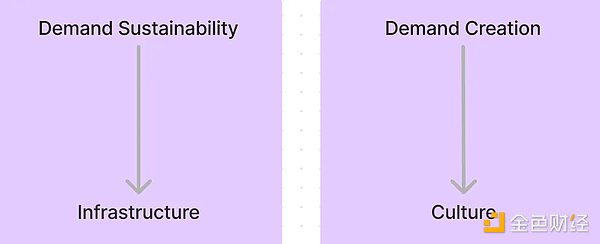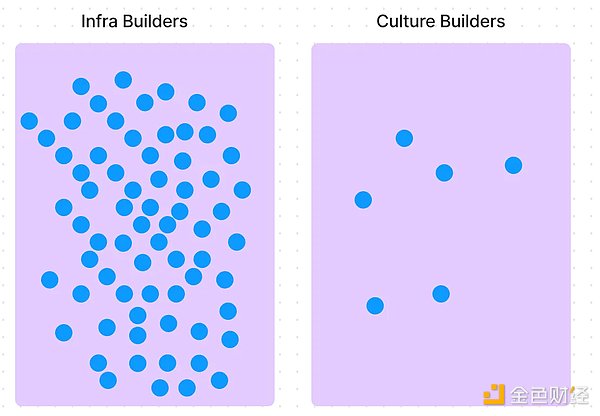Author: Luca Schnetzler Translation: Shan Ouba, Golden Finance
A year ago, I began to rethink my stance on NFTs. In the context of a depressed market, the concept of utility seemed meaningless. The idea of allocating value from X to Y seemed doomed to fail. Immersed in a utility-centric mindset, I began to question the purpose of my efforts. Until it suddenly dawned on me that NFTs are culture, nothing more. Today, my thesis on NFTs is crystal clear: Culture and identity will ultimately prevail, and everything else will lose meaning over time. While the subjectivity of identity may vary, the impact of culture is undoubtedly profound. This epiphany sparked my obsession with the trajectory of culture and tokenization.
Right now, the cryptocurrency industry is in a huge pursuit of the next breakthrough technological innovation. It feels like 98% of the industry’s talent and resources are heading toward this goal. While I acknowledge the importance of solving infrastructure challenges, I believe that the end state of cryptocurrency is not far away. So, as the industry looks to create cheaper, faster transaction solutions, I ask you: in a world where cryptocurrencies have reached peak technical performance, what comes next?
I believe the future of culture is tokenized. I envision a world where the majority of cryptocurrency tokens are culture tokens — tokens that act as indicators of how people speculate on various cultures past and present. Today, we can see the embryonic form of this through what we know as meme tokens, or NFTs. However, I believe the potential and opportunity is greater than most people realize.
First, let’s address the elephant in the room: why tokenize culture? The answer is two-fold. First, tokens create aligned incentives that incentivize community members to embrace said culture, ultimately driving the culture further. Second, tokenization democratizes culture, allowing anyone with an internet connection to participate. The combination of aligned incentives and access democratization leads me to believe that a future where tokenized culture is the norm will do more for the spread of culture than it will harm it.
This opens up a whole new category of tokens called Culture Tokens. Under Cultural Tokens, the subcategories are defined as follows:
Social Tokens (STs) - Tokenization of People/Influence
Intellectual Property Tokens (IPTs) - Tokenization of Intellectual Property
Consumer Brand Tokens (CBTs) - Tokenization of Consumer Brands
Non-Fungible Tokens (NFTs) - Tokenization of Artifacts and Collectibles (Veblen Goods)
Historical Artifact Tokens (HATs) - Tokenization of Historical Artifacts
Meme Tokens - Tokenization of Memes
Movie Tokens (MTs) - Tokenization of Movement
Some crypto purists may look down on some of these trends, and I have to say that I view these as negative EV perspectives. All of the above have driven retail demand and increased interest in our industry despite evaluating the headlines over the past few years. Why? I think the answer is simple, it’s to satisfy consumer needs. Consumers understand memes, they understand toys on the shelf, they understand veblen goods. Tokenizing culture works because people understand the culture. Like it or not, the average person doesn’t care about ZK Proofs, Optimistic Rollups, or Parallelized EVMs. All of these things are amazing, but they don’t make the headlines to get more people involved.
I view the relationship between infrastructure and culture as a yin and yang. Without the right infrastructure, on-chain culture will never thrive, and without culture, our industry will never grow.

So I encourage anyone who disdains cultural tokens to rethink their approach. Like it or not, we all need each other.
Building the Future of Tokenized Culture
I wrote this post to inspire more crypto builders to build for culture. Even though the image below is a doodle I scribbled on Figma, I think the representation is still correct. Everyone is going left and no one is going right. That’s a good thing, at least for those of you reading this, it means you’re here early.

People certainly want on-chain culture, and they’re hungry for more. However, while the industry is focused on building more efficient versions of the same, few builders are developing products around what’s necessary to accelerate on-chain culture. In my opinion, this is where the biggest opportunity lies right now. If all goes as planned, there should be consumer applications on the chain with enterprise value exceeding the base chain it rests on. Culture is more than just IP and memes, it can also be applications, marketplaces, or identity layers, and so much more. In the real world, companies like Instagram, Snapchat, and LVMH are all examples of businesses building, creating, and pioneering culture.
Paradigm Shift
A paradigm shift is happening between endgame and culture, and this shift is not only in crypto, but also in traditional finance. Crypto moves at laser-like speed, and this speed gives us a glimpse of the potential that financial markets may have in the near future. In the 90s you had Bowie Bonds, in 2020 you had $GME, and today you have $DJT, they all represent some form of culture. For $GME it stands for “screw the bankers and the short sellers”, for $DJT you are speculating on Donald J. Trump, and in a sense it is a social token. Unfortunately for traditional finance, this future may not materialize in its more or less peak form due to the huge barriers to entry. Regardless, this concept of a financial asset driven by culture and trends is not new, and with the speed and accessibility of cryptocurrencies, it will only become more common.
An Interesting Idea
Tokenizing culture can also be taken literally, and I actually think there’s a huge opportunity for someone to take a буквальное (bú kwà zhì - literal) approach. Imagine a world where you tokenize real-world intellectual property and have it live on-chain as an interesting beacon that the community can speculate on. Here’s how it would work:
X Protocol/Launch Platform is created to bring real-world intellectual property on-chain -> The protocol partners with Star Wars to launch an officially sanctioned Star Wars token -> Star Wars licenses its intellectual property to X Protocol, which launches the official $Stars token. Through the licensing agreement, Star Wars gets 15% of the token supply, which unlocks monthly. X Protocol backs this officially-backed $Stars token, sparking the curiosity of hundreds of millions of Star Wars fans. If even just 1% of Star Wars fans become curious about crypto, it would be a huge win for our entire space. The snowball effect of this type of model working perfectly could open the floodgates to new types of onboarding methods in the crypto retail industry.
Some may question the rationale behind this move and its benefits. The answer lies in brands’ pursuit of attention and revenue. This model offers both, while avoiding the systemic hit that brands will suffer from failing to compete for attention in an AI-dominated world, while also offering the opportunity to earn more revenue on their IP by tokenizing their IP (which will likely generate higher returns than selling to traditional PE/M&A).
Concluding Thoughts
In my opinion, the biggest opportunity in crypto today is the development of a cultural layer. The best entrepreneurs don’t build for themselves, they build for their users. It’s clear that crypto users want more culture, and they want it now. To all crypto entrepreneurs out there, I’d say it’s time to give the people what they want, the future of culture won’t build itself.
 Kikyo
Kikyo








